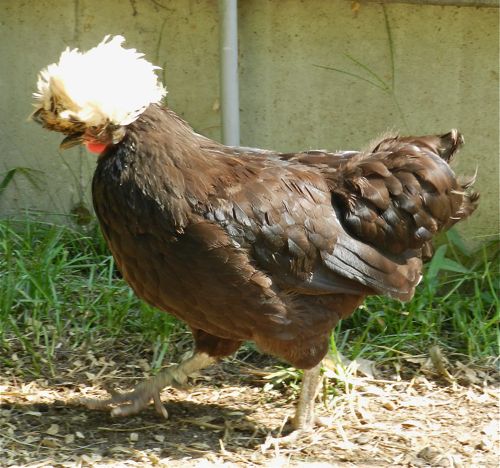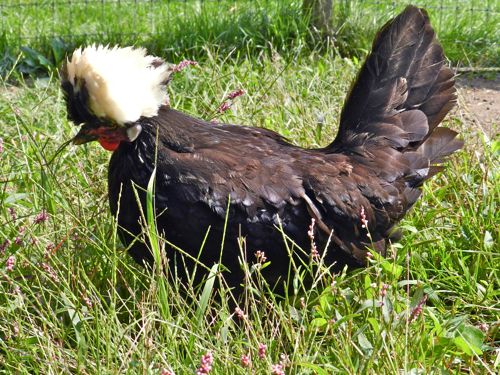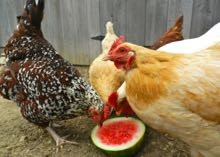At first glance the two Polish hens, Tina Turner and Siouxsie are look-alikes. However, I can tell them apart because Tina has spurs. Sometimes that happens – a female chicken will grow lethal-looking nails. The spurs don’t match Tina’s personality. She is just as ditzy and mild-mannered as Siouxsie.
These days, there’s an easier way to tell them apart than by looking at their legs. Check the tails.
This is Tina.
And this is Siouxsie.
Notice that Tina’s tail feathers have fallen off. She’s molting. All of the hens will be soon, but Tina is first. Although you can read in books that chickens lose their feathers in a certain progression, the reality is that each bird is different. Some will lose just their tail feathers. Others will lose feathers in patches, looking like they suddenly developed a mysterious tropical skin disease. In all cases, the hen will stop laying. She needs to put her energy into growing new feathers, not eggs. This conveniently coincides with the winter season, when there are fewer daylight hours, and it’s colder, all signals to stop egg production. You can turn on an electric light to encourage more eggs, but that only works once their feathers grow back. For some chickens that happens in a few weeks, for others it takes all winter.
The Gems are also losing feathers, but it’s not a true molt. They’re growing in their adult plumage, and losing their baby quills. Depending on the breed, some of the Gems will be laying through the winter of their first year, and others won’t start until February.
I’m often asked, “when will my hen grow her feathers back?” and “when will she lay again?” There’s no definitive answer. Even chickens that are the same age and breed, like Tina and Siouxsie, molt at different paces. Siouxsie continues to lay four pointy white medium-sized eggs weekly. Tina lays none, not since her tail feathers fell out, which, by the way, happened all at once. They’ll start laying again when they’re ready, and I don’t know when that will be. As they age, the onset of laying after a molt is later in the spring.
There are some questions that I can answer. To the query, “Will my scrawny-feathered hen be cold?” The answer is, “No.” Then I’m asked, “Even with her skin showing? Doesn’t she need heat?” The answer remains “No.” Be amused. Miss the eggs. But don’t worry. It’s all normal.



Terry, have you had hens that loose all their wing feathers at once?
I have, actually have two bantams right now with no wing feathers. Poor things. All my hens seem to want to jump half way up the ramp leading into the coop and these poor hens have a heck of a time with no wing feathers. I’ve seen them do several 1/2 backward summersaults off the ramp. Forget getting on or staying on the roost.
Has to be completly “unnatural”. Can’t see the wild cousins of the chicken doing that, predator dinner in a heartbeat.
I’ve never seen that! I’ve had chickens look like they turned into “naked-necks” but never naked wings.
To clarify a tad, it’s mainly just the primary and secondary flight feathers, not all the feathers on the wings, now that would be a photo op.
Well, my chickens seems to continuously differ from the norm in one way or another. My Mary, a Black Australorp, is really looking horrible these days in a molt. She does however continue to lay. I only have four and can easily distinguish each hen’s eggs. I still have four egg days and Mary’s always are the lightest brown with a wrinkle on the pointy end. Rhoda’s are darker, Sue Ann’s are smaller and slightly speckled, Phyllis’ are blue. Maybe she’ll stop later in the molt, she’s now about 3 weeks in.
Thank you for this post. Our Brit-Red is molting and earned the nickname Patch because she looks so funny. My husband is using the shop vac to keep the feathers in the run under control. Nice to know they all molt differently as our Delaware hasn’t been laying and was suspecting she was molting but not to the degree the others were.
I’ve found feeding animal protein at 1/2 oz/bird day in the AM’s will significantly shorten the time a chicken spends in molt. This will get hens back into production, and covered with feathers for the cold much sooner. Average time: 5 weeks, some longer, few shorter.